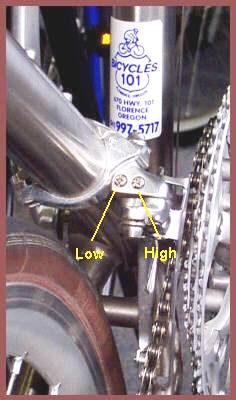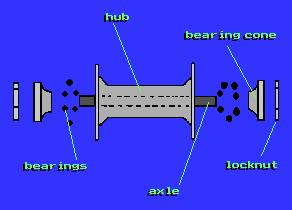Bicycle Glossary A B C D E F G H I J K L M N O P Q R S T U V W X Y Z
Bicycle Glossary - L
![]()
Lacquer - A thin, semi-transparent paint which dries quickly. Lacquer is applied in several layers, as many as twenty. Between some layers, the paint is rubbed out (polished), leaving an extremely glossy finish. The final layers of lacquer may be clear. Mylar flakes which look like metal can be added to give the bike a "metalflake" finish. The first layers of paint after the primer can be gold, silver or white, which makes any color applied on top look more vibrant. With lacquers, you can have metalflake candy-apple red, for instance, which is just amazing in its color quality. However, lacquer finishes tend to be fragile. They are easily scraped or chipped.
Two techniques which work especially well with lacquer are overspray painting, and polishing. In
overspraying, after the bike is painted a solid color, another color is sprayed just at the intersections, and faded toward the middle of the frame tubes. Polishing is seldom seen, but very custom. The middle sections of the three main tubes, and possibly the ends of the chainstays, seatstays and fork blades are polished with successively finer grades of sand paper, and finally cloth and polishing compound. They are then covered with tape, and the rest of the bike is painted. Finally, the tape is removed, and then the entire bike is sprayed with clear lacquer. The result appears to be
chromed middles of the frame tubes.
Spraying lacquer takes a lot of technique. You want to keep the spraygun close and move fast, because
at any distance beyond about 30 cm (a foot), the paint dries before it hits the bike, resulting in a mechanically weak or blotchy paint job.
My suggestion is to enjoy this discussion, but do not paint your own bike. It is difficult to do with anywhere near the quality of the factory finish. But even more important, it is a dangerous undertaking. Getting long-term diseases related to poisoning yourself is not a pretty thing to do. - Jeff
See also: Enamel, Imron, Overspray
25-ways: Painting bikes professionally
Ladies' bike - A bike with a frame that has no toptube, or a toptube that runs parallel to the downtube. The original intent was to produce a bike that women wearing skirts could ride. Interestingly, ladies' bikes are safer then men's bikes, even for men. See also: Men's bike.
Lathe - A machine for precisely shaping metal. Bike shops sometimes have a lathe for custom fabrication of bicycle components. A lathe generally spins the metal piece against a cutter that can be slowly moved in and out and sideways along the turning piece. Bike shops use 'metal lathes.' A 'wood lathe,' is another kind of lathe that spins faster, and uses less precise handheld chisels for shaping wood. See also milling machine.
Left-threaded - Nuts and bolts which are threaded the reverse of the standard way. To tighten a left-threaded part, turn it as if you were removing a jar lid. Bicycle parts frequently have left threading, since many bicycle parts rotate. Rotating parts might otherwise unscrew themselves depending on which direction they usually turn. The most common left-threaded parts are left side pedals, freewheel lockplates, and one-piece ("American") crank locknuts and left side bearing cones). Synonyms: Left-hand threaded, Reverse threading
Limit screw - A screw on a derailleur which controls how far the derailleur can travel. Each derailleur has two limit screws. One limits how far the derailleur can move toward the largest sprocket, and the other controls the maximum movement toward the smallest sprocket. If a limit screw is too loose, the chain can fall off the sprocket when shifted. If too tight, it will not engage the sprocket, or will engage slowly. Synonym: Adjusting screw.

Limit screws on a front derailleur
Locknut - A thin nut on a bottom bracket spindle or hub axle which keeps bearing cones from changing their adjustment. Using plain old friction, the locknut jams the cone on the axle threads so it cannot easily turn. In some cases, a slot is ground along the threaded axle, and a washer with a tab that slides in the slot is inserted between the bearing cone, and the locknut. This is a much better system, since when tightening the locknut, the cone will not tend to turn also.
Locknuts are also found on other components such as pedal spindles, and on sidepull centerbolts.

Locknuts on a hub
Lock-washer - A lock washer is a flat metal ring that is trapped between nuts or bolts and the items they fasten together. The lock washer has a sharp split in it, or several serrations which will help prevent nuts and bolts coming loose due to vibration.
Low gear - A small sprocket at the cranks turning a large one on the rear wheel will cause the bicycle to go slowly, but will be easy to pedal. This is a low gear.
Lubrication - Metal parts that rub against each other change shape, known as wearing out. When the parts are coated with a microscopically thin layer of oil or grease, they no longer rub against each other. They rub against the lubrication, which can't wear out. Since oil and grease have no shape to begin with, they can't change shape. Metal parts rubbing against each other also cause friction which makes the bicycle harder to ride. Lubrication reduces friction.
Oil and grease are almost the same thing. Grease is oil that is so thick it cannot drip. Grease not only makes a good lubricant, but is great for keeping parts from becoming stuck together over time due to electrolytic action or corrosion. Chain lube is a special oil which is less likely to attract dust than other oils. If you use conventional oil on a chain, it has to be cleaned more often than if you use chain lube. Use grease on ball bearings, and the threaded portion of nuts and bolts. Use grease on the inserted portion of handlebar stems and seatposts. Grease cable inner wires when installing new cables. Use grease within coaster brakes. Use oil on brake and derailleur pivots, pawls and ratchets (freewheels and planetary gear sets).
As long as bicycles have had chains, people have been searching for ways to lubricate the chains without making a mess. Many ideas have been tried such as graphite (powdered carbon), and paraffin wax. Wax has an interesting story. Several years ago a popular bicycle book was published that said the correct way to lubricate a chain was to soak it in a pot of liquid paraffin wax heated on a cooking stove. We tried that because it sounded too weird to be true. Turns out it didn't work at all! Our guess is that the author read another book published in the British Empire suggesting to use "paraffin" to clean the chain, and took a little license in writing up the details without trying his own advice. Paraffin in England means kerosene, a thin liquid good for cleaning chains.
Luggage carrier - A system for carrying cargo. In most cases, it is a steel or aluminum platform mounted above the rear wheel onto which packages must be tied. See
also: Pletcher carrier.
![]()
Tell a Friend About BikeWebSite
Please feel free to link your web pages to www.bikewebsite.com.
Disclaimer
Although I have attempted to cover the major safety issues, I cannot be responsible for your use of this information. Working on bicycles is dangerous if you do it without considering consequences of bolts left loose, known problems which are ignored, things which should be replaced but are glued instead, and so on. Proceed carefully at your own risk and use common sense. Jeff Napier, and all agents associated with this information, do not offer any guarantee or warranty for your use of this information
Copyright © 1991-2014, bikewebsite.com
.